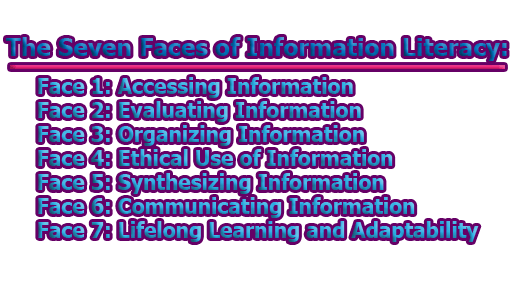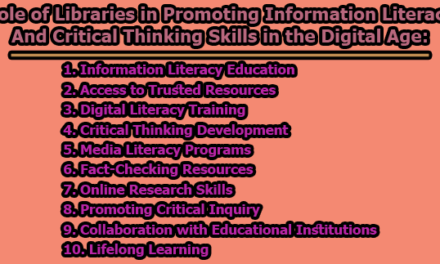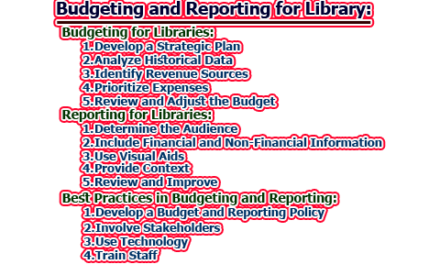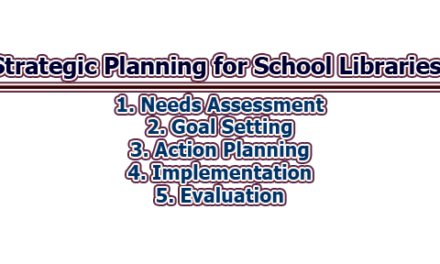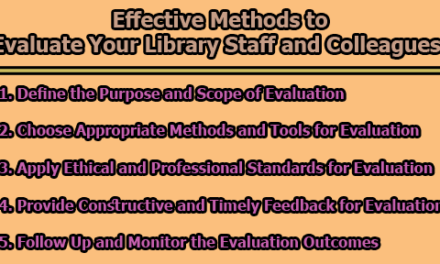The Seven Faces of Information Literacy:
In today’s information-rich world, the ability to navigate, evaluate, and utilize information effectively is critical. Information literacy has become an essential skill set for individuals in various domains, from academia to everyday life. This article explores the concept of information literacy and presents a detailed analysis of the seven faces of information literacy. By delving into each face individually, we aim to provide a comprehensive framework that equips individuals with the necessary skills to thrive in the digital age.
Face 1: Accessing Information:
1.1. Locating and Retrieving Information: Locating and retrieving information is the foundation of effective information literacy. This face focuses on developing skills to identify and access relevant sources efficiently. It involves understanding various information platforms, such as databases, online catalogs, and search engines, and employing search techniques to optimize results. Individuals need to learn how to formulate effective search queries, use Boolean operators, and utilize advanced search features to refine their searches. Additionally, they should be familiar with techniques such as citation chaining, which involves following references to discover additional relevant sources.
1.2. Understanding Search Strategies: Search strategies are crucial for navigating the vast amount of information available. This face emphasizes the importance of developing effective search strategies to retrieve accurate and relevant information. It covers techniques such as selecting appropriate keywords, using Boolean operators (AND, OR, NOT), employing truncation and wildcards, and applying search filters to narrow down results. Understanding how search algorithms work and being aware of search engine biases are also important considerations.
1.3. Utilizing Libraries and Digital Resources: Libraries, both physical and digital, offer invaluable resources for accessing information. This face focuses on understanding the resources available in libraries, including books, journals, archives, and specialized databases. It also explores digital libraries, institutional repositories, open-access resources, and other online platforms. Individuals learn how to navigate library catalogs, access digital collections, and utilize online databases effectively. Furthermore, they gain an understanding of interlibrary loan services and document delivery options to access materials beyond their institution’s holdings.
1.4. Evaluating Information Sources: Accessing information is not solely about finding sources; it also involves evaluating their credibility, reliability, and relevance. This face emphasizes the critical evaluation skills necessary to determine the trustworthiness of sources. Individuals learn to assess the authority and expertise of authors, verify the accuracy and currency of information, recognize potential bias or conflicts of interest, and evaluate the overall quality of sources. They also explore different source types, such as scholarly articles, books, websites, and social media, and understand how to assess their appropriateness for specific information needs.
Face 2: Evaluating Information:
2.1. Critical Evaluation Skills: Critical evaluation skills are essential for assessing the quality and reliability of information. This face focuses on developing a critical mindset to analyze information critically and thoughtfully. Individuals learn to question assumptions, recognize logical fallacies, identify gaps in arguments, and assess the validity of claims. They also understand the importance of considering multiple perspectives and engaging in thoughtful inquiry when evaluating information.
2.2. Determining Credibility and Reliability: Determining the credibility and reliability of information sources is a crucial aspect of information literacy. This face explores techniques for assessing the trustworthiness of sources, such as evaluating the author’s credentials, reputation, and affiliations. Individuals learn to recognize reputable publishers and journals, examine peer-review processes, and evaluate the overall reputation of publishing platforms. They also gain an understanding of indicators of quality, such as citation counts and impact factors, when assessing scholarly sources.
2.3. Recognizing Bias and Perspective: Recognizing bias and understanding different perspectives are vital skills for evaluating information critically. This face emphasizes the need to be aware of implicit and explicit biases present in information sources. Individuals learn to identify potential biases based on the author’s language, tone, and underlying assumptions. They also develop strategies for seeking out diverse viewpoints and considering alternative perspectives to gain a more comprehensive understanding of a topic.
3.4. Assessing Currency and Relevance: The currency and relevance of information are important factors in evaluating its value. This face focuses on understanding the timeliness of information and its applicability to specific contexts. Individuals learn to assess the currency of sources by examining publication dates, updates, and new editions. They also develop skills to evaluate the relevance of information by considering its alignment with research questions or information needs. Additionally, they explore the importance of understanding the historical context of information and how it may impact its current relevance.
Face 3: Organizing Information:
3.1. Information Organization Principles: Organizing information is crucial for efficient retrieval and use. This face explores principles and techniques for structuring information effectively. Individuals learn about classification systems, metadata standards, and ontologies. They gain an understanding of how information is organized in libraries, archives, and databases. Additionally, they explore the concept of information architecture and its role in organizing digital information and creating intuitive user interfaces.
3.2. Creating Effective Taxonomies and Categories: Creating taxonomies and categories is a key skill for organizing information systematically. This face focuses on developing the ability to design and create effective classification systems. Individuals learn about different types of taxonomies, such as hierarchical, faceted, and semantic taxonomies. They explore techniques for categorizing information, including controlled vocabulary, subject headings, and tagging. They also understand the importance of user-centered design and user feedback in developing taxonomies that meet users’ information needs.
3.3. Utilizing Information Management Tools: Information management tools are instrumental in organizing and accessing information efficiently. This face explores various tools and technologies available for information organization, such as reference management software, citation managers, and content management systems. Individuals learn how to use these tools to organize their own collections of information, manage citations and references, and collaborate with others effectively. They also explore the benefits and limitations of different tools and select the most appropriate ones based on their specific requirements.
3.4. Developing Personalized Systems: Developing personalized systems for organizing information enhances individual productivity and retrieval efficiency. This face focuses on developing strategies for creating personal information management systems. Individuals learn to customize their organizational methods based on their preferences and needs. They explore techniques for creating efficient folder structures, using tagging and labeling systems, and developing personal knowledge management systems. Additionally, they gain an understanding of the importance of regularly reviewing and updating their organizational systems to maintain their effectiveness.
Face 4: Ethical Use of Information:
4.1. Understanding Intellectual Property Rights: Understanding intellectual property rights is essential for ethical information use. This face explores the concepts of copyright, fair use, and Creative Commons licenses. Individuals learn about the rights of creators and the limitations and exceptions to copyright. They also gain an understanding of the public domain and open access resources, promoting the responsible use and dissemination of information while respecting intellectual property rights.
4.2. Plagiarism and Copyright Infringement: Avoiding plagiarism and copyright infringement is crucial in information literacy. This face focuses on understanding the ethical implications of using others’ work without appropriate attribution or permission. Individuals learn to differentiate between proper citation and plagiarism, understand the consequences of academic misconduct, and develop skills for paraphrasing, summarizing, and citing sources correctly. They also explore strategies for avoiding unintentional infringement of copyright in the digital environment.
4.3. Respecting Privacy and Confidentiality: Respecting privacy and confidentiality is an integral part of ethical information use. This face explores the importance of protecting individuals’ personal information and respecting confidentiality agreements. Individuals learn about privacy laws, data protection regulations, and ethical considerations related to collecting, storing, and sharing sensitive information. They also gain an understanding of ethical practices in data management, informed consent, and anonymization.
4.4. Promoting Responsible Information Sharing: Responsible information sharing involves considering the impact and consequences of sharing information with others. This face explores ethical considerations in disseminating information to different audiences. Individuals learn about the potential effects of misinformation, the importance of fact-checking, and the responsible use of social media and other communication channels. They also gain an understanding of digital citizenship and the ethical responsibilities associated with sharing information in online communities.
Face 5: Synthesizing Information:
5.1. Extracting Key Ideas: Extracting key ideas from information sources is crucial for synthesizing information effectively. This face focuses on developing skills for identifying and summarizing main points, arguments, and evidence. Individuals learn techniques for skimming and scanning texts, taking effective notes, and extracting essential information. They also explore strategies for identifying central themes and concepts within a body of information.
5.2. Combining Multiple Sources: Combining multiple sources of information enables individuals to generate comprehensive and well-supported insights. This face emphasizes the skills needed to integrate information from diverse sources. Individuals learn to compare and contrast different perspectives, identify commonalities and contradictions, and synthesize information to develop a cohesive understanding of a topic. They also explore techniques for organizing and structuring synthesized information effectively.
5.3. Identifying Patterns and Relationships: Identifying patterns and relationships in information enhances individuals’ ability to draw meaningful conclusions. This face focuses on developing skills for recognizing connections, trends, and cause-effect relationships within the information. Individuals learn to analyze data, interpret visualizations, and identify patterns in text, images, and other forms of information. They also explore techniques for discerning correlations, causation, and other types of relationships within complex information sets.
5.4. Constructing Knowledge and Insights: Constructing knowledge and insights involves synthesizing information to develop new understandings and perspectives. This face emphasizes the transformative aspect of information literacy. Individuals learn to go beyond surface-level comprehension and engage in critical thinking, reflection, and analysis. They explore how synthesized information can lead to new insights, interpretations, and applications. They also develop the ability to communicate their knowledge and insights effectively to others.
Face 6: Communicating Information:
6.1. Effective Communication Strategies: Effective communication is crucial for conveying information clearly and persuasively. This face focuses on developing skills for organizing and structuring information in a coherent manner. Individuals learn techniques for creating logical outlines, crafting well-structured arguments, and presenting information in a concise and engaging way. They also explore the importance of clarity, coherence, and effective use of language in written and oral communication.
6.2. Tailoring Information to Different Audiences: Tailoring information to different audiences ensures that the message is appropriately conveyed and understood. This face emphasizes the importance of audience analysis and adaptation. Individuals learn to consider the knowledge, interests, and needs of their target audience when communicating information. They develop skills for adjusting the level of complexity, using appropriate terminology, and selecting relevant examples and visuals to enhance audience comprehension and engagement.
6.3. Utilizing Various Media and Formats: Effective communication involves utilizing various media and formats to convey information effectively. This face explores different communication tools and platforms, such as written reports, presentations, infographics, videos, and interactive media. Individuals learn to select the most suitable medium for their intended message and audience. They also gain skills in creating visually appealing and engaging visual and multimedia materials.
6.4. Ethical Considerations in Information Dissemination: Ethical considerations play a vital role in the communication of information. This face focuses on promoting responsible and ethical information dissemination practices. Individuals learn about the ethical guidelines and codes of conduct related to information sharing and publication. They explore issues such as accuracy, transparency, attribution, and respectful engagement with diverse perspectives. They also develop an awareness of potential biases and ethical pitfalls when communicating information in different contexts.
Face 7: Lifelong Learning and Adaptability:
7.1. Cultivating a Growth Mindset: Cultivating a growth mindset is crucial for continuous learning and development. This face focuses on developing attitudes and beliefs that embrace challenges, persist in the face of obstacles, and seek opportunities for growth. Individuals learn strategies for overcoming self-limiting beliefs, embracing feedback, and fostering a positive attitude toward learning. They also explore the concept of resilience and the importance of maintaining motivation and curiosity throughout their information literacy journey.
7.2. Continuous Learning and Professional Development: Information literacy is an ongoing process that requires continuous learning and professional development. This face emphasizes the importance of staying updated with new information sources, technologies, and research methods. Individuals learn strategies for lifelong learning, such as engaging in self-directed learning, participating in professional networks, attending workshops and conferences, and accessing online resources and courses. They also develop skills in evaluating and selecting trustworthy sources of information for their ongoing learning needs.
7.3. Adapting to Technological Advancements: Technological advancements have a significant impact on the information landscape. This face focuses on developing skills for adapting to new technologies and digital tools. Individuals learn about emerging technologies, such as artificial intelligence, machine learning, and blockchain, and their implications for information access, evaluation, and communication. They explore strategies for evaluating and adopting new technologies that can enhance their information literacy skills and keep pace with the evolving digital environment.
7.4. Embracing Change and Future Trends: Embracing change and anticipating future trends are essential for staying relevant in the information age. This face emphasizes the need to be proactive in identifying and adapting to changing information environments. Individuals explore future trends in information literacy, such as data literacy, media literacy, and information ethics. They develop an understanding of the societal, cultural, and technological factors that influence information literacy and adapt their skills and practices accordingly.
In conclusion, the seven faces of information literacy encompass a wide range of skills and competencies necessary for engaging with information in a discerning and meaningful manner. By developing proficiency in accessing information, evaluating its credibility, organizing and synthesizing knowledge, and effectively communicating and adapting to changing contexts, individuals can become empowered and responsible users of information. These skills are not only essential for academic success but also for lifelong learning, critical thinking, and active participation in a knowledge-driven society.
FAQs:
What is the concept of the seven faces of information literacy?
The concept of the seven faces of information literacy is a framework that provides a comprehensive view of the skills and competencies involved in information literacy. It recognizes that information literacy goes beyond simply finding and accessing information. Instead, it encompasses multiple dimensions or “faces” that include accessing information, evaluating its credibility, organizing and synthesizing knowledge, communicating information effectively, and embracing lifelong learning and adaptability.
Why are the seven faces of information literacy important?
The seven faces of information literacy are important because they provide a holistic approach to developing information literacy skills. By understanding and developing proficiency in each face, individuals can enhance their ability to navigate and engage with information effectively. These skills are essential in academic settings for conducting research, evaluating sources, and communicating findings. Moreover, in today’s information-rich society, where misinformation and fake news abound, information literacy skills are critical for making informed decisions, participating in civic discourse, and being responsible consumers and creators of information.
How can the seven faces of information literacy be applied in practical situations?
The seven faces of information literacy can be applied in various practical situations. For example, when conducting research for a project or paper, individuals can use their skills in accessing information to locate relevant sources through databases, search engines, and libraries. They can then evaluate the credibility and reliability of the sources they find, considering factors such as the author’s expertise, publication date, and potential bias. Organizing information skills can be employed to create an effective structure for organizing and managing sources and notes. Synthesizing information skills can help individuals extract key ideas from multiple sources, identify patterns and relationships, and construct their own knowledge and insights. Communicating information skills enable individuals to present their findings in a clear, coherent, and audience-appropriate manner, utilizing various media and formats. Finally, lifelong learning and adaptability skills are crucial for staying updated with new information resources, technologies, and evolving trends.
How can educators and institutions integrate the seven faces of information literacy into their teaching and curriculum?
Educators and institutions can integrate the seven faces of information literacy into their teaching and curriculum by incorporating relevant learning activities and assessments. This can include designing assignments that require students to access and evaluate information from various sources, organize and synthesize information to develop arguments or projects, and effectively communicate their findings. Providing instruction and guidance on search strategies, critical evaluation skills, information organization principles, and effective communication techniques are essential components. Additionally, incorporating discussions and activities that promote lifelong learning and adaptability, such as exploring emerging technologies and discussing ethical considerations, can further enhance students’ information literacy skills. It is also beneficial to collaborate with librarians and information professionals who can provide expertise and resources to support the development of information literacy skills across disciplines.
Can the seven faces of information literacy be applied in professional settings?
Absolutely. The seven faces of information literacy are not limited to academic settings but are highly relevant in professional settings as well. In today’s knowledge-driven economy, professionals across various fields need to access, evaluate, and utilize information effectively. Whether it’s conducting market research, staying updated with industry trends, or making informed decisions based on reliable sources, information literacy skills are crucial. The ability to organize and synthesize information, communicate effectively with colleagues and stakeholders, and adapt to new technologies and changing information landscapes are highly valued in the professional world. By integrating the seven faces of information literacy into professional development programs and workplace training, organizations can empower their employees to become skilled and responsible information users.

Assistant Teacher at Zinzira Pir Mohammad Pilot School and College

